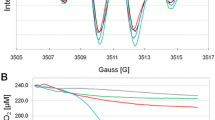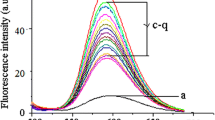Abstract
Free radical reactions are believed to play an important role in the mechanism of Cr(VI)-induced carcinogenesis. Most studies concerning the role of free radical reactions have been limited to soluble Cr(VI). Various studies have shown that solubility is an important factor contributing to the carcinogenic potential of Cr(VI) compounds. Here, we report that reduction of insoluble PbCrO4 by glutathione reductase in the presence of NADPH as a cofactor generated hydroxyl radicals (•OH) and caused DNA damage. The •OH radicals were detected by electron spin resonance (ESR) using 5,5-dimethyl-N-oxide as a spin trap. Addition of catalase, a specific H2O2 scavenger, inhibited the •OH radical generation, indicating the involvement of H2O2 in the mechanism of Cr(VI)-induced •OH generation. Catalase reduced •OH radicals measured by electron spin resonance and reduced DNA strand breaks, indicating •OH radicals are involved in the damage measured. The H2O2 formation was measured by change in fluorescence of scopoletin in the presence of horseradish peroxidase. Molecular oxygen was used in the system as measured by oxygen consumption assay. Chelation of PbCrO4 impaired the generation of •OH radical. The results obtained from this study show that reduction of insoluble PbCrO4 by glutathione reductase/NADPH generates •OH radicals. The mechanism of •OH generation involves reduction of molecular oxygen to H2O2, which generates •OH radicals through a Fenton-like reaction. The •OH radicals generated by PbCrO4 caused DNA strand breakage.
Similar content being viewed by others
References
Witmer CM, Harris R, Shupack SI: Oral bioavailability of chromium from a specific site. Environ Health Perspect 92: 105–110, 1991
Bartlett RJ: Chromium cycling in soils and water: Links, gaps, and methods. Environ Health Perspect 92: 17–24, 1991
De Flora S, Bagnasco M, Serra D, Zanacchi P: Genotoxicity of chromium compounds: A review. Mutat Res 238: 99–172, 1990
Aiyar J, De Flora S, Wetterhahn KE: Reduction of chromium(VI) to chromium(V) by rat liver cytosolic and microsomal fractions: Is DT-diaphorase involved? Carcinogenesis 13: 1159–1166, 1992
Freeman B, Lioy PJ: Exposure to chromium dust from homes in chromium surveillance project. Arch Environ Health 52: 213–226, 1997
Hays RB: Review of occupational epidemiology of chromium chemicals and respiratory cancer. Sci Total Environ 71: 331–339, 1988
Langard S: One hundred years of chromium and cancer: A review of epidemiological evidence and selected case reports. Am J Ind Med 17: 189–215, 1990
Norseth T: The carcinogenicity of chromium. Environ Health Perspect 40: 121–130, 1981
Tandon SK, Saxena DK, Gaur JS, Chandra SV: Comparative toxicity of trivalent and hexavalent chromium. Environ Res 15: 90–99, 1978
Petrilli FL, De Flora S: Toxicity and mutagenicity of hexavalent chromium on Salmonella typhimurium. Appl Environ Microbiol 33: 805–809, 1977
Majone F, Levis AG: Chromosomal aberrations and sister-chromatid exchanges in Chinese hamster cells treated in vitro with hexavalent chromium compounds. Mutat Res 67: 231–238, 1979
Connett PH, Wetterhahn KE: Metabolism of the carcinogenic chromate by cellular constituents. Struct Bonding 54: 93–124, 1983
Shi X, Chiu A, Chen CT, Halliwell B, Castranova V, Vallyathan V: Reduction of chromium(VI) and its relationship to carcinogenesis. J Toxicol Environ Health 2: 101–118, 1998
Shi X, Dalal NS: Chromium(V) and hydroxyl radical formation during the glutathione reductase-catalyzed reduction of chromium(VI). Biochem Biophys Res Commun 163: 627–634, 1989
Leonard S, Wang S, Zang L, Castranova V, Vallyathan V, Shi X: Role of molecular oxygen in the generation of hydroxyl and superoxide anion radicals during enzymatic Cr(VI) reduction and its implication to Cr(VI)-induced carcinogenesis. J Environ Pathol Toxicol Oncol 19: 49–60, 2000
Shi X, Mao Y, Knapton AD, Ding M, Rojanasakul Y, Gannett PM, Dalal NS, Liu K: Reaction of Cr(VI) with ascorbate and hydrogen peroxide generates hydroxyl radicals and causes DNA damage: Role of Cr(IV)-mediated Fenton-like reaction. Carcinogenesis 15: 2475–2478, 1994
Ye J, Zhang X, Young HA, Mao Y, Shi X: Chromium(VI)-induced nuclear factor-κB activation in intact cells via free radical reactions. Carcinogenesis 16: 2401–2405, 1995
Chen F, Ding M, Lu Y, Leonard SS, Vallyathan V, Castranova V, Shi X: Participation of MAP kinase p38 and IκB kinase in chromium(VI)-induced NF-κB and AP-1 activation. J Environ Pathol Toxicol Oncol 19: 231–238, 2000
Wang S, Leonard SS, Ye J, Ding M, Shi X: The role of hydroxyl radical as a messenger in Cr(VI)-induced p53 activation. Am J Physiol 279: C868–C875, 2000
Ye J, Wang S, Leonard SS, Sun Y, Butterworth L, Antonini J, Ding M, Rojanasakul Y, Vallyathan V, Castranova V, Shi X: Role of reactive oxygen species and p53 in chromium(VI)-induced apoptosis. J Biol Chem 274: 34974–34980, 1999
Zhang Z, Leonard SS, Wang W, Vallyathan V, Castranova V, Shi X: Cr(VI) induces cell growth arrest through hydrogen-peroxide-mediated reactions. Mol Cell Biochem 222: 77–83, 2001
Ye X, Shi X: Gene expression profile in response to chromium-induced cell stress in A549 cells. Mol Cell Biochem 222: 189–197, 2001
Hayes RB: Review of occupational epidemiology of chromium chemicals and respiratory cancer. Sci Total Environ 71: 331–339, 1988
IARC. Chromium, Nickel and Welding. In: IARC Monographs on the Evaluation of the Carcinogenic Risk of Chemicals to Humans. IARC, Lyon, France, 1990, 49, pp 49–256
Patierno SR, Banh D, Landolph JR: Transformation of C3H/10T1/2 mouse embryo cells to focus formation and anchorage independence by insoluble lead but not soluble calcium chromate: Relationship to mutagenesis and internalization of lead chromate particles. Cancer Res 48: 5280–5288, 1988
Elias Z, Poirot O: Cytotoxic and neoplastic transforming effects of industrial hexavalent chromium pigments in Syrian hamster embryo cells. Carcinogenesis 10: 2043–2052, 1989
Wise JP, Leonard JC, Patierno SR: Clastogenicity of lead chromate particles in hamster and human cells. Mutat Res 278: 69–79, 1992
Wise JP, Stearns DM, Wetterhahn KE, Patierno SR: Cell-enhanced dissolution of carcinogenic lead chromate particles: The role of individual dissolution products in clastogenesis. Carcinogenesis 15: 2249–2254, 1994
Wise JP, Orenstein JM, Patierno SR: Inhibition of lead chromate clastogenesis by ascorbate: Relationship to particle dissolution and uptake. Carcinogensis 14: 429–434, 1993
Daniel LN, Mao Y, Saffiotti U: Oxidative DNA damage by crystalline silica. Free Radic Biol Med 14: 463–472, 1993
Shi X, Dalal NS: Chromium(V) and hydroxyl radical formation during the glutathione reductase-catalyzed reduction of chromium(VI). Biochem Biophys Res Commun 163: 627–634, 1989
Shi X, Dalal NS: On the hydroxyl radical formation in the reaction between hydrogen peroxide and biologically generated chromium(V) species. Arch Biochem Biophys 277: 342–350, 1990
Shi X, Dalal NS: Evidence for a Fenton-type mechanism for the generation of ·OH radical in the reduction of Cr(VI) in cellular media. Arch Biochem Biophys 281: 90–95, 1990
Shi X, Mao Y, Knapton A, Ding M, Rojanasakul Y, Gannett PM, Dalal NS, Liu K: Reaction of Cr(VI) with ascorbate and hydrogen peroxide generates hydroxyl radicals and causes DNA damage: Role of a Cr(IV)-mediated Fenton-like reaction. Carcinogenesis 15: 2475–2478, 1994
Buettner GR: ESR parameters of spin adducts. Free Radic Biol Med 3: 259–303, 1987
Ione S, Kawanish S: ESR evidence for superoxide, hydroxyl and singlet oxygen produced from hydrogen peroxide and nickel(II) complex of glycylglycyl-L-histidine. Biochem Biophys Res Commun 159: 445–451, 1989
Yim MB, Chock PB, Stadtman ER: Copper, zinc superoxide dismutase catalyzes hydroxyl radical production from hydrogen peroxide. Proc Natl Acad Sci USA 87: 5006–5010, 1990
Halliwell B: Protection against tissue damage in vivo by deferoxamine: What is its mechanism of activation? Free Radic Biol Med 7: 645–651, 1989
Keller RJ, Rush JD, Grover TA: Spectrophotometric and ESR evidence for vanadium(IV) deferoxamine complexes. J Inorg Biochem 41: 268–276, 1991
Author information
Authors and Affiliations
Rights and permissions
About this article
Cite this article
Leonard, S.S., Vallyathan, V., Castranova, V. et al. Generation of reactive oxygen species in the enzymatic reduction of PbCrO4 and related DNA damage. Mol Cell Biochem 234, 309–315 (2002). https://doi.org/10.1023/A:1015917922980
Issue Date:
DOI: https://doi.org/10.1023/A:1015917922980




